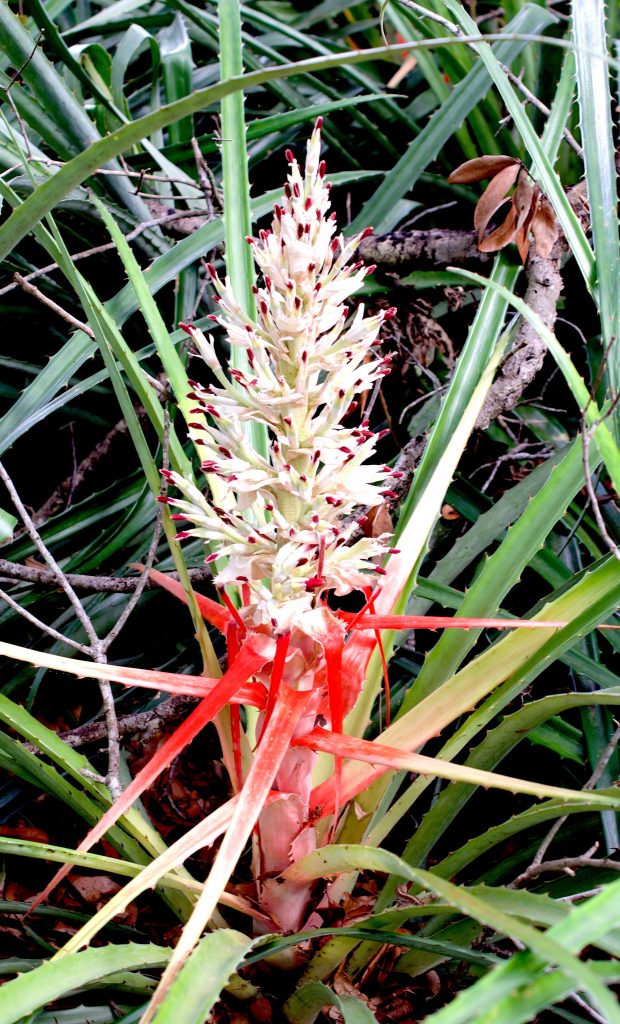
Wild Pineapple is very showy when in blossom. Photo by Green Deane
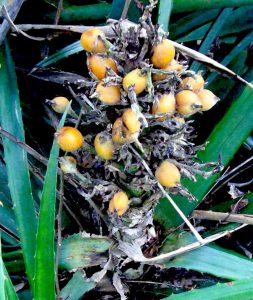
Cut the fruit off with a pair of nippers. Photo by Green Deane
Wild Pineapple has a beautiful blossom around April, depending upon the seasonal conditions. Six or seven months later you can harvest the lemon-yellow fruit. Both the blossom and the fruit can be exceptionally attractive. Its blossoms were one reason why Wild Pineapple was used in landscaping a century ago. You can often find it where spas, inns and hotels were established near railroad stops (along with bamboo and cultivated grapes. Also look for chunks of coquina rock.)
I wish I could eat Wild Pineapple. Well, I can but I pay a price for it. I get a “scruffy” tongue. The fruit looks good and tastes good. But, within a few minutes of eating I can’t taste anything and that lasts for a few hours. Some folks are like me and lose their sense of taste while others have no problem. They eat them without issue. The only possible variable I can think of that I have not tried tasting them when extremely ripe. It might be sub-acid then. Most of the plant, however, is edible when young and cooked (but avoid the stinging hairs on the flowers.) Also note the leaves have recurved spines that go in both directions so once it grabs you getting free is tough. You can read about Wild Pineapple here.
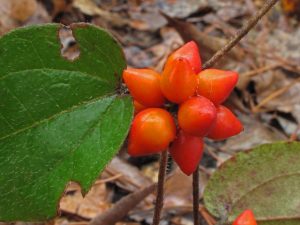
The Sarsaparilla Vine has pointed red berries.
This past weekend my foraging class spotted Smilax pumila. It’s a red-berried Smilax and one of two locally with red fruit. The other, S. walteri, is not rare but I don’t see it too often, about once a decade. The quick way to tell them apart is S. walteri berries are round on the end and S. pumila are pointed. Also called the Sarsaparilla Vine it’s people friendly and one of the few Smilaxes without prickles. We know the root of S. pumila is edible because it has been used to flavor root beer and other beverages include an alcoholic beer. And while the young tips and leaves are edible I don’t know if the berries are. Most smilax berries never reach the point of a taste worth foraging for. At best when they are old and look like fresh raisins they are tolerable. I haven’t eaten any red berries off any Smilax just out of form (they are red for a reason which could range from attracting birds to being toxic. I just don’t know.) Most Smilax berries are dark purple or black so I view Smilax red berries with suspicion. However, Smilex aspera in Greece has red berries and the fruit is edible. So maybe I am being over cautious. Then again I note S. apera berries while edible are not bright red when ripe but a dark red towards purple black. While “Smilax” refers to a nymph in Greek mythology the word itself comes from a Greek word that means “poison.” It was believed if you rubbed a baby with the Smilax vine you protected it from poisoning. You can read about Smilax here.

Keynote Speakers at the Florida Herbal Conference Linda and Luke Black Elk.
It’s time to be thinking about two conferences in February, Earthskills in Hawthorn, and the Florida Herbal Conference near Lake Wales. I lead plant walks at both events. Earthskills is Feb 7-11 and the Florida Herbal Conference is Feb 23-25. While the former organizes later in the year the Florida Herbal Conference is already accepting registrations. It is usually sold out so register early. Because you read this EatTheWeeds newsletter you get a discount for the Florida Herbal Conference. If you register between now and January 31 using the code FHC2018_GREENDEANE you can get a 30% discount. Keynote speakers this year at the Florida Herbal Conference are Linda and Luke Black Elk from the Standing Rock Reservation. Linda (of the Catawba Nation) is an ethnobotanist specializing in teaching about culturally important plants and their uses as food and medicine. She is a lecturer at Sitting Bull College in Fort Yates, North Dakota. Luke Black Elk (Thítȟuŋwaŋ Lakota) is a storyteller, grassroots activist, and traditional spiritualist. He has conducted research in water restoration, sustainable building design, and food sovereignty, and hopes to use these techniques to encourage a more traditional way of life among his people. Luke has lived on the Cheyenne River Sioux Reservation his entire life, becoming deeply involved in cultural and community activities. For more information about the Florida Herbal Conference go here.
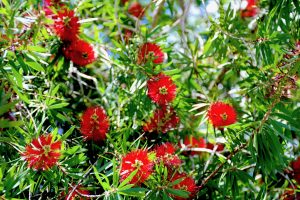
Bottle Brush Tree blossoms and leaves can be used for tea. Photo by Green Deane
The Greeks were perhaps the first people to call things what they were such as “yoke mate” for spouse or “shiny leather” for the Reishi mushroom. Then along came Latin that liked to be soft and flowery. English, conversely, is punchy and muscular. It gets to the point quickly. When you have a choice while writing always opt for English-based words over Latin-based ones. Extinguish The Conflagration doesn’t say it as well as Put Out The Fire! So when it came to a tree in which the leaves were used for tea it became the Tea Tree. And its oil became Tea Tree Oil with most folks forgetting the leaves can also be used for tea. The same down-to-earth approach was used with a very close relative to the Tea Tree, the Callistemon, or the Bottle Brush Tree. You can use the blossoms of the Bottle Brush Tree for tea or the leaves. The blossom tea tastes better. Or, you can combine them. You can also use white Bottle Brush Tree blossoms for tea. By the way Latin was used for scientific names because it is a dead language that doesn’t change. To read about the Bottle Brush Tree go here.
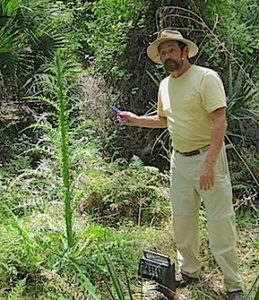
Foraging classes are held rain or shine. Photo by Nermina Krenata
Foraging Classes: The winter season does not slow us down with a lot of cooler weather plants coming up. There is one class this weekend, Sunday in Orlando, because of the holiday.
Sunday, November 26th, Blanchard Park, 10501 Jay Blanchard Trail, Orlando, FL 32817. 9 a.m. Meet by the tennis courts near the WMCA building.
Saturday, December 2nd, Red Bug Slough Preserve, 5200 Beneva Road, Sarasota, FL, 34233. 9 a.m.
Sunday, December 3rd, Dreher Park, 1200 Southern Blvd., West Palm Beach, 33405, 9 a.m. We meet just north of the science center.
Sunday, December 10th, Bayshore Live Oak Park, Bayshore Drive. Port Charlotte. Meet at the parking lot at the intersection of Bayshore Road and Ganyard Street. 9 a.m.
Saturday, December 16th, Blanchard Park, 10501 Jay Blanchard Trail, Orlando, FL 32817. 9 a.m. Meet by the tennis courts near the WMCA building.
To learn more about the classes go here.

Green Deane DVD Set
All of Green Deane’s videos available for free on You Tube. They do have ads on them so every time you watch a Green Deane video I get a quarter of one cent. Four views, one cent. Not exactly a large money-maker but it helps pays for this newsletter. If you want to see the videos without ads and some in slightly better quality you can order the DVD set. It is nine DVDs with 15 videos on each for a total of 135 videos. Many people want their own copy of the videos or they have a slow service and its easier to order then to watch them on-line. The DVDs make a good gift for that forager you know especially on long, cold winter months. Individual DVDs can also be ordered or you can pick and choose. You can order them by clicking on the button on the top right hand side of this page (if your window is open wide enough.) Or you can go here.

Green Deane Forum
Want to identify a plant? Looking for a foraging reference? Do you have a UFO, an Unidentified Flowering Object you want identified? On the Green Deane Forum we chat about foraging all year. And it’s not just about warm-weather plants or just North American flora. Many nations around the world share common weeds so there’s a lot to talk about. There’s also more than weeds. The reference section has information for foraging around the world. There are also articles on food preservation, and forgotten skills from making bows to fermenting food. One special section is “From the Frightening Mail Bag” where we learn from people who eat first then ask questions later. You can join the forum by clicking on “forum” in the menu.
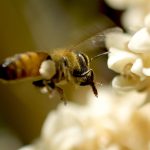
Bee In Flight
It’s an old story, been around some 80 years: Scientists say bumblebees can’t fly. However man-made dragonflies can. Before we get to the dragonflies what about the aerodynamically-challenged bumblebee? The it-can’t-fly story has two sources: A dinner conversation in Germany or a book in French about insects. The problem in each case the engineers who did the calculating viewed the bee as a fixed-wing object which would indeed make them flightless. However, their wings are more like helicopter blades, to be more precise, reverse-pitch semirotary blades. A moving wing generates a lot more lift than a stationary one thus bumblebees do indeed fly. That’s also how artificial dragonflies fly.
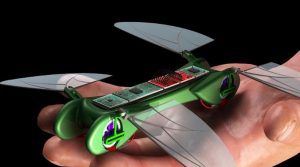
A Dragonfly that obeys you.
The Techjet Dragonfly is an “unmanned autonomous vehicle” (UAV) that flies, hovers and can collect data with its onboard sensors. The Dragonfly was developed at Georgia Tech with a million dollars from the Air Force. The design has four wings and is a little larger than a real dragonfly, measuring six inches long and weighing 25 grams, which is just shy of an ounce. Power is supplied by a 250 mAh lithium polymer battery providing hover times of 8 to 10 minutes and a combined hover/flight time of 25 to 30 minutes. They also have up to 20 environmental sensors and cameras as well as GPS capabilities. The drone Dragonfly can provide live and mobile feed for photography, security, gaming, spying and swarm robotics. They designed four models: Alpha ($250) is the basic model. Delta is faster and will cost $500. Gamma has more programmable features and a price tag of $750. The Omega model is the fully-loaded dreadnaut dragonfly going for $1,499. What I want to know is will birds leave them alone, or, will we need mechanical birds to keep those robotic swarms in check?
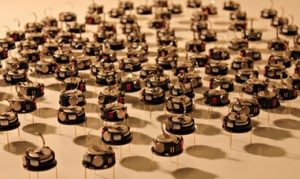
Will swarms of bots replace bees?
“Swarm Robotics” is fairly clear in concept but fuzzy in application. It’s a lot of simple, cheap little machines, doing something better than a large, expensive one. Got it. Applications are more jargon than practical at the moment. However, I can think of one: If honeybees do indeed die off we will need something to pollinate plants, and make honey. More importantly will you be bothered at some future picnic by a mechanical bee trying to steal some jelly? You could swat it but Big Brother Beekeeper has a video of you and knows exactly where you are. Time to arm the deadly nerve gas stinger…
This is issue 279. The main portion of the website is now functional though small bugs persist. We are working on them. Thanks for you patience.
If you would like to donate to Eat The Weeds please click here.

